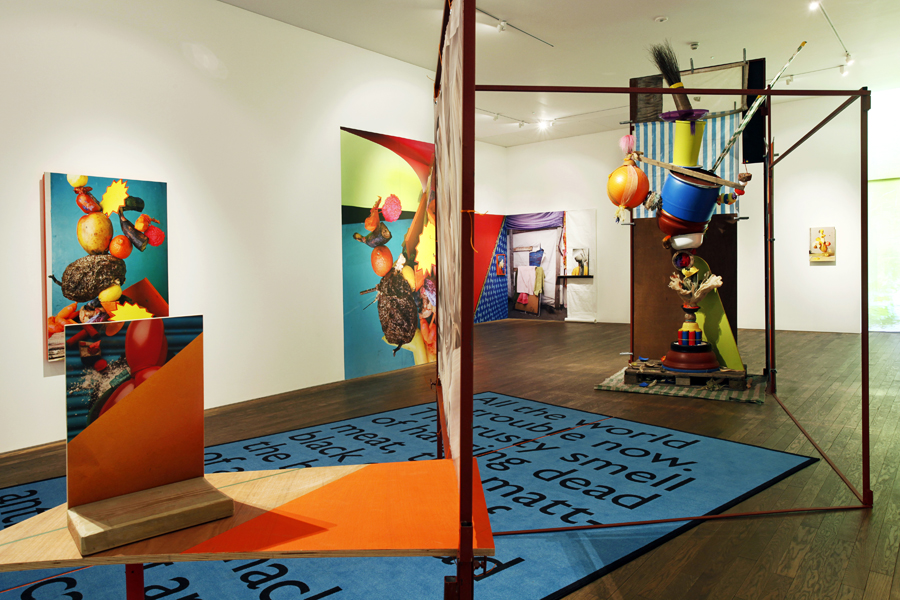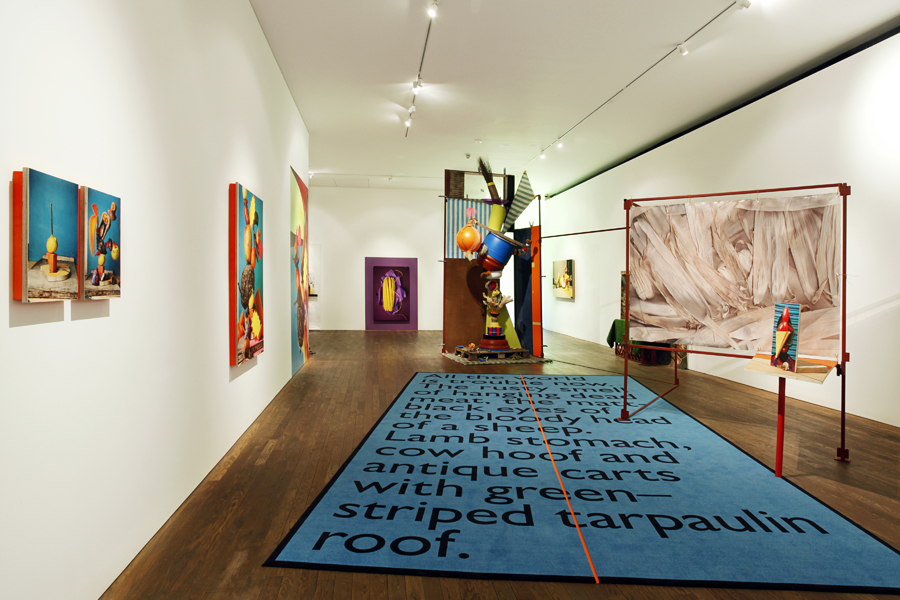DALSTON ANATOMY SOLO SHOW BY LORENZO VITTURI
Curator and Project Manager FRANCESCA SERAVALLE
I collaborated with the artist Lorenzo Vitturi since the first shooting curating and supporting the development of the project, from the book to the touring exhibition. Every location requested a new design in order to create every time a set specific exhibition to fit perfectly with space. The exhibition has been designed to inspire continuous visual stimulation to the visitors.
2015 Yossi Milo Gallery New York, solo show
Hyeres - Festival Internazionale della Moda (FR), 1° Prize Award
CNA – Centre National de L’Audiovisuel – Luxembourg, solo show
2014 IMA Gallery Tokyo - solo show
2014 The Photographers’ Gallery - Londra, solo show
Deutsche Börse Photography Foundation Prize - nominated artist, 2015
2013 Foam Museu
Unseen Photoshock
V&A Photoshock
For the past year, Lorenzo Vitturi has been fascinated by the Ridley Road Market in East London. It’s a multicultural market where West African vegetables meet Caribbean fruits, and Asiatic fishes meet English apples. It takes place every day in the heart of Dalston, where London’s new creative generation is, step-by-step, intermingling with the African culture. Vitturi wants to save retain an image of this authentic society before gentrification sets in and this poor area is totally converted into a place for the rich. So he photographs the people there and collects all kind of organic objects and matter, and takes them back to his studio. Black-eyed beans, nyanya chungu, smoked barracuda, azü from Gambia, soro wisa, ashanti piper guineense, schotch bonnet, ogede, plantain leaves, onion alïbasa, white round summer squash, cassava, beetroot, pink peppers, English apples, ose, and petite kola. Each item in the photos has a story to tell, a long intercontinental journey behind it. Most have come from different corners of Asia, West Africa, Niger, Nigeria, Ivory Coast, Ghana, Guinea, Liberia, and Sierra Leone, bringing the tastes and fragrances of home to the African community in London. They represent the resistance of the African food tradition to the globalisation of big supermarket chains.
In the market, everything from the micro to the macro appears related – objects to people; people to spaces; and spaces to objects, in an endless chain of
likenesses. Everything belongs together, as if all theelements had chosen one another. Day after day, the people and the colours in the market seemed to Vitturi
to have their own order and harmony, and the hidden connections became clear, transposed into a fruit-installation in progress. The banana, with its onion
nose and pepper coiffure, resembles the profile of the hybrid people living in this multi-ethnic area. The dried rolled up barracuda from Thailand perched on an unstable pile of rotten English apples is reminiscent of a metallic necklace on a nobby neck.
Vitturi carried out anatomical research on decomposition and re-composition, attempting to recreate the same explosive and precarious beauty that inspired
him in the first place. The market is considered a physical identity, a body; subdivided by shape and colour. Afterwards, in his studio, applying a scientific
with visionary approach, Vitturi reconstructed new anatomies, having studied the systems and functions through dissection and analysis of the single parts.
At the Ridley Road market, every day is like a closed circle of life. The morning consists of the building of the stall, the daytime of the exposing of fruits, and then comes the decay, and the closing of the market at night. The beauty of decay belongs to the aesthetic of Lorenzo Vitturi, who was born in beautiful and decadent Venice. Decay is the quality he attempts to recreate in real life in the studio. This research is also about finding the perfect moment before destruction sets in. These sculptures are temporary; they cannot last more than a few minutes or hours. This is the biological process, the life of an installation. The photograph is the last step in this method, the only record of the sculpture’s existence, and thus the only way to see it. The central theme here is the transience of life. Especially when, just before its end, everything is still resisting.
AWARDS
2015 Shortlisted, 16th Premio Arte Cairo, Cairo Editore, Milan, IT
2014 Winner, Grand Prix of Photography, Hyères International Festival of Fashion and Photography, Hyères, FR
2013 Winner, Best Show of The Year 2013, 3H Foam and Gieskes Strijbis Fonds, Amsterdam, NL
![]()
![]()
![]()
![]()
![]()
![]()
![]()
Curator and Project Manager FRANCESCA SERAVALLE
I collaborated with the artist Lorenzo Vitturi since the first shooting curating and supporting the development of the project, from the book to the touring exhibition. Every location requested a new design in order to create every time a set specific exhibition to fit perfectly with space. The exhibition has been designed to inspire continuous visual stimulation to the visitors.
2015 Yossi Milo Gallery New York, solo show
Hyeres - Festival Internazionale della Moda (FR), 1° Prize Award
CNA – Centre National de L’Audiovisuel – Luxembourg, solo show
2014 IMA Gallery Tokyo - solo show
2014 The Photographers’ Gallery - Londra, solo show
Deutsche Börse Photography Foundation Prize - nominated artist, 2015
2013 Foam Museu
Unseen Photoshock
V&A Photoshock
For the past year, Lorenzo Vitturi has been fascinated by the Ridley Road Market in East London. It’s a multicultural market where West African vegetables meet Caribbean fruits, and Asiatic fishes meet English apples. It takes place every day in the heart of Dalston, where London’s new creative generation is, step-by-step, intermingling with the African culture. Vitturi wants to save retain an image of this authentic society before gentrification sets in and this poor area is totally converted into a place for the rich. So he photographs the people there and collects all kind of organic objects and matter, and takes them back to his studio. Black-eyed beans, nyanya chungu, smoked barracuda, azü from Gambia, soro wisa, ashanti piper guineense, schotch bonnet, ogede, plantain leaves, onion alïbasa, white round summer squash, cassava, beetroot, pink peppers, English apples, ose, and petite kola. Each item in the photos has a story to tell, a long intercontinental journey behind it. Most have come from different corners of Asia, West Africa, Niger, Nigeria, Ivory Coast, Ghana, Guinea, Liberia, and Sierra Leone, bringing the tastes and fragrances of home to the African community in London. They represent the resistance of the African food tradition to the globalisation of big supermarket chains.
In the market, everything from the micro to the macro appears related – objects to people; people to spaces; and spaces to objects, in an endless chain of
likenesses. Everything belongs together, as if all theelements had chosen one another. Day after day, the people and the colours in the market seemed to Vitturi
to have their own order and harmony, and the hidden connections became clear, transposed into a fruit-installation in progress. The banana, with its onion
nose and pepper coiffure, resembles the profile of the hybrid people living in this multi-ethnic area. The dried rolled up barracuda from Thailand perched on an unstable pile of rotten English apples is reminiscent of a metallic necklace on a nobby neck.
Vitturi carried out anatomical research on decomposition and re-composition, attempting to recreate the same explosive and precarious beauty that inspired
him in the first place. The market is considered a physical identity, a body; subdivided by shape and colour. Afterwards, in his studio, applying a scientific
with visionary approach, Vitturi reconstructed new anatomies, having studied the systems and functions through dissection and analysis of the single parts.
At the Ridley Road market, every day is like a closed circle of life. The morning consists of the building of the stall, the daytime of the exposing of fruits, and then comes the decay, and the closing of the market at night. The beauty of decay belongs to the aesthetic of Lorenzo Vitturi, who was born in beautiful and decadent Venice. Decay is the quality he attempts to recreate in real life in the studio. This research is also about finding the perfect moment before destruction sets in. These sculptures are temporary; they cannot last more than a few minutes or hours. This is the biological process, the life of an installation. The photograph is the last step in this method, the only record of the sculpture’s existence, and thus the only way to see it. The central theme here is the transience of life. Especially when, just before its end, everything is still resisting.
AWARDS
2015 Shortlisted, 16th Premio Arte Cairo, Cairo Editore, Milan, IT
2014 Winner, Grand Prix of Photography, Hyères International Festival of Fashion and Photography, Hyères, FR
2013 Winner, Best Show of The Year 2013, 3H Foam and Gieskes Strijbis Fonds, Amsterdam, NL







